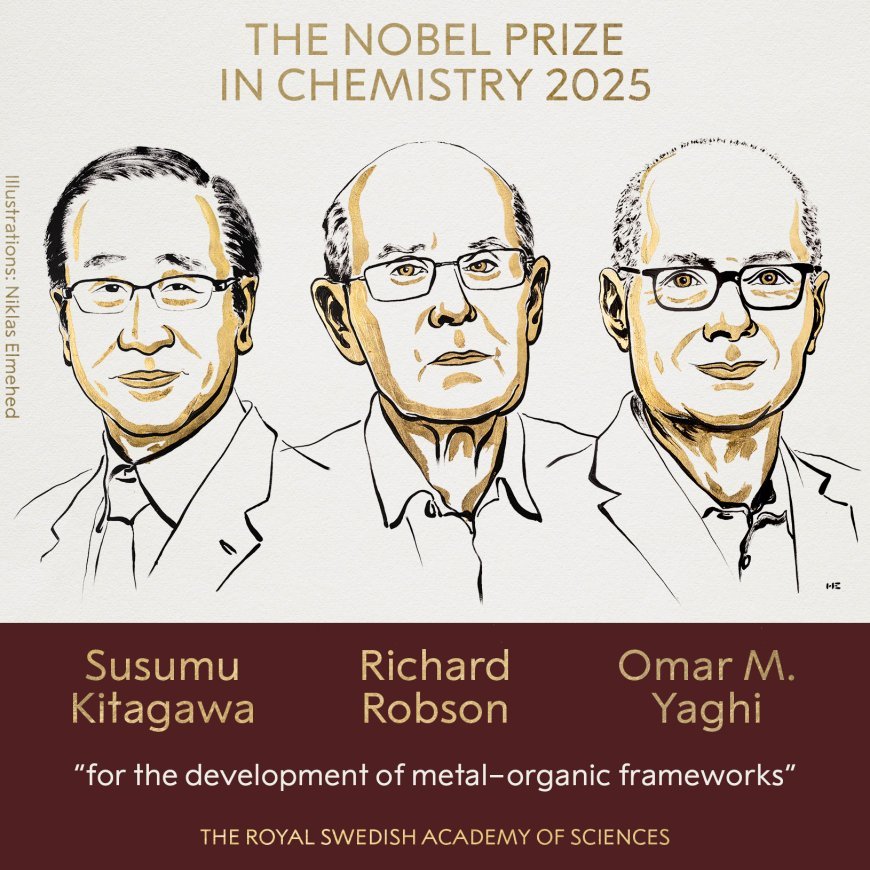A Triumph for Innovation: 2025 Nobel Prize in Chemistry Honors MOF Pioneers

Scientific discovery has once again claimed center stage. On October 8, 2025, the Royal Swedish Academy of Sciences awarded the Nobel Prize in Chemistry to Susumu Kitagawa, Richard Robson, and Omar M. Yaghi for their groundbreaking work on metal-organic frameworks (MOFs). Their research, hailed as “material architecture of the 21st century,” promises to reshape fields from climate science to renewable energy and water purification.
What Are Metal-Organic Frameworks (MOFs)?
At their core, MOFs are crystalline compounds composed of metal ions or clusters linked by organic molecules, forming 3D frameworks with high porosity. In simpler terms, imagine a scaffold or lattice riddled with microscopic pores and channels through which gases, liquids, or ions can pass. The real magic is that the internal surface area of these materials is astronomical: a few grams can rival the area of a football pitch.
Because of this porous structure, MOFs can store, filter, trap, or release molecules under controlled conditions. Over the past decades, chemists have tailored MOFs with specific pore sizes, chemical properties, and stability — making them ideal for applications like:
-
Carbon dioxide capture (helping fight climate change)
-
Harvesting water from the air, even in arid regions
-
Gas storage and separation, including hydrogen or methane
-
Removing toxins from water, breaking down “forever chemicals” (PFAS)
The Nobel Committee even likened these frameworks to Hermione’s magical handbag—small in appearance but capable of storing enormously more than meets the eye.
The Laureates: Builders, Stabilizers, Visionaries
Though all three scientists collaborated conceptually, each played a complementary role in turning MOFs from concept to transformative tool:
-
Richard Robson laid foundational work in the late 1980s, combining metal ions and organic linkers to construct porous crystals.
-
Susumu Kitagawa refined stability and gas transport, showing how MOFs could reliably absorb and release gases under varying conditions.
-
Omar Yaghi advanced pa precise, modular “assembly” of MOF structures and drove their expansion into practical, large-scale applications.
Yaghi’s own life story is compelling: born in Amman, Jordan, he navigated personal and infrastructural hardships in youth and rose to become a leading professor at the University of California, Berkeley.
Why This Nobel Matters
This year’s chemistry award is not just about molecules — it’s a celebration of practical, scalable innovation that can address pressing global challenges. Water scarcity, greenhouse gas emissions, and pollution: MOFs offer a toolbox to mitigate each.
Moreover, it underlines a broader shift: the boundaries between chemistry, materials science, and environmental engineering are blurring. The laureates didn’t just invent a compound; they built a platform for future generations of researchers to customize materials for specific challenges.
Challenges & Opportunities Ahead
That said, turning MOF research into large-scale industrial and commercial solutions isn’t trivial. Scientists will need to overcome:
-
Stability under real-world conditions (moisture, heat, chemical stress)
-
Economical large-scale synthesis and reproducibility
-
Sustainability of materials and lifecycle impacts
But with the momentum of Nobel recognition, more funding, interdisciplinary collaboration, and public interest will follow. The prize can catalyze breakthroughs in clean energy, carbon-neutral technologies, water extraction, and toxin removal.
Final Thoughts: A New Dawn for Chemistry
The 2025 Nobel Prize in Chemistry stands as a testament to human ingenuity at its finest: conceptual creativity meeting technical rigor, and theory crossing into transformative technology. Kitagawa, Robson, and Yaghi have not just expanded the frontiers of chemistry — they’ve handed us tools to solve some of the most urgent problems of our times.
As researchers build on MOF platforms and industries seek scalable applications, this moment may be remembered as the turning point: when chemists forged new frameworks not only in materials, but in possibility itself.
What's Your Reaction?
 Like
0
Like
0
 Dislike
0
Dislike
0
 Love
0
Love
0
 Funny
0
Funny
0
 Angry
0
Angry
0
 Sad
0
Sad
0
 Wow
0
Wow
0




























